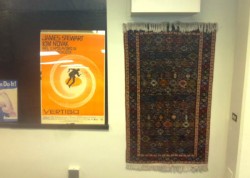One day, during freshman year, I walked past room 2040 and stopped for a minute to glance inside. Instead of the standard barren walls, cold tile floors, and uncomfortable gray desks, the classroom had a completely different atmosphere that drew me in.
Two years later, I now spend 42 minutes a day sitting in David Klingenberger‘s fully carpeted classroom. The room is a sanctuary from the dull and uninviting classrooms that my classmates and I are used to; the fluorescent lights don’t seem quite as harsh when they are complemented by aesthetically pleasing rugs, paintings, and posters.
Junior Lila Gilbert believes that the abundant lamps are a contributing factor to the cozy atmosphere in Klingenberger’s room.
“Fluorescent lights aren’t the only thing that light the room, and it gives it more of a warm feeling,” she said.
The lights that adorn the back of his classroom have a functional use. In addition to GAW, Klingenberger teaches Images, a film class, so the lamps must be dim enough so as not to interfere with the students’ viewing of various forms of media, but also provide enough light so that the students can clearly see what they’re writing.
Along with the back-lighting of the room, the classroom has another special feature: stadium-style seating. Desks are placed on risers to ensure that every student has a good view of the screen.
Though these unique aspects of the classroom serve the important purpose of facilitating film viewing, pure functionality wasn’t the only reason that Klingenberger decided to decorate the way that he did.
Though Klingenberger often buys art himself for his classroom – during a recent trip to California, he purchased a piece he thought his students might like – pupils also give him art as gifts from time to time.
Whales are a prominent motif in the classroom’s decor. Having taught the novel “Moby Dick” on and off throughout his career, multiple students have deemed it appropriate to buy him whale memorabilia over the years.
Whales are just one kind of gift that he receives from his students, some of whom are very talented artists.
“A lot of times students will create art, and I’ll go to one of the student art shows, and I’ll buy the piece,” he said.
Though students do try and give him the art, Klingenberger insists on paying for it to give students the confidence that their art is worthy of being bought.
Despite not being able to afford his habit of collecting art until after college, Klingenberger has long harbored a love for paintings and other types of artwork. As a youth, he had the option of checking art out from a local library, which he took advantage of frequently.
“I always thought that was funny, I would check out the Mona Lisa, and people would come over and I’d be like, ‘It’s not real. It’s not the real one,'” he recalled.
Klingenberger seems to have a special connection to everything in his room. Upon being asked which work he liked best, he had a particularly difficult time selecting a favorite.
From an abstract blue square painted by his friend and Yale alumna who now has Alzheimer’s disease to a red and black piece of tapestry that was once his mother-in-law’s, from a picture of the Chrysler building that was a gift from his partner to a “Tree of Life” poster that was given to him by a student, he seems to have a unique appreciation for each and every piece, especially the rugs.

Interestingly, Klingenberger has rugs from all over the world. One particularly beautiful carpet comes from Egypt. He was travelling down the Nile River and decided on a whim to purchase the rug that he describes as “having a really weird design.”
No matter how beautiful or abstract the art in his room may be, there is no doubting that students appreciate the effort he puts into making his classroom feel less like a prison cell and more like a pleasant environment in which learning is not only possible but even enjoyable.
Klingenberger hopes that the atmosphere in his classroom will help foster interesting and productive conversation, and according to junior Connie Dang, it does.
“It’s more like an apartment than a school room. It has personality, and I think that that helps students feel more comfortable and open,” she said.
Junior Nicole Christodolou agrees.
“I love walking into Mr. Klingenberger’s classroom! Most school classes are so boring because the teachers use it for a period or two for a specific class, but Mr. Klingenberger’s room is only his and he’s decorated it with film posters, quotes and pictures. It just makes the atmosphere more cozy and personal. I feel like we can better connect with him as a person, not just a teacher,” she said.
The unique classroom contrasts strongly with the unfriendly where students spend the majority of their day. As a result, Klingenberger’s class not only to stands out, but also gives students the opportunity to learn about and discuss something new.
“If [students] can discover Louie Armstrong and what a great trumpet player he was, or if they can find some love of rugs from some other country — maybe they’ve never even thought of rugs as an art form — or if they can fall in love with Radiohead or Samuel Beckett, I think that would be a great thing. [It’s] as important as all the other things that happen in this classroom.”


